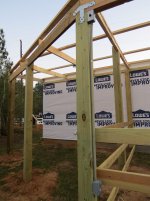QRTRHRS
Elite Member
The dusk to dawn light on my barn started acting up going off and on. A known to be good sensor did not help. Seems like these lights go about five years then are throw away items.
I decided to put one of those glass globed barn lights with the metal protector on the outside with a CFL bulb. I wanted to direct the light down if possible so I took the old dusk to dawn housing down and pondered on it a bit. After removiing the transformer and circuitry, I bugged out the sensor on this one and another that I had laying around.
Turns out, you can wire the red to your positive on the light fixture, tie the commons (white) together and connect the black from the sensor to your hot coming in from the panel. At least that was common to both light housings I had.
Using some self tapping screws, I secured the light fixture to the metal bracket and metal part of the globe. After finishing up the wiring and securing the globe/fixture to the head, I hit the breaker, covered the sensor and viola, light!
With only a 20 watt CFL, I have plenty of light in the front of the barn. The original sensor turns it on and off. Sure beats running one of those 175 watt mercury vapor or a lessor wattage high pressure sodium.
I decided to put one of those glass globed barn lights with the metal protector on the outside with a CFL bulb. I wanted to direct the light down if possible so I took the old dusk to dawn housing down and pondered on it a bit. After removiing the transformer and circuitry, I bugged out the sensor on this one and another that I had laying around.
Turns out, you can wire the red to your positive on the light fixture, tie the commons (white) together and connect the black from the sensor to your hot coming in from the panel. At least that was common to both light housings I had.
Using some self tapping screws, I secured the light fixture to the metal bracket and metal part of the globe. After finishing up the wiring and securing the globe/fixture to the head, I hit the breaker, covered the sensor and viola, light!
With only a 20 watt CFL, I have plenty of light in the front of the barn. The original sensor turns it on and off. Sure beats running one of those 175 watt mercury vapor or a lessor wattage high pressure sodium.
